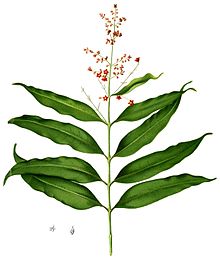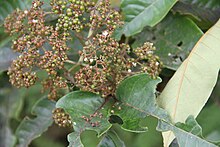St. John's wort family
| St. John's wort family | ||||||||||||
|---|---|---|---|---|---|---|---|---|---|---|---|---|

Spotted St. John's Wort ( Hypericum maculatum ) |
||||||||||||
| Systematics | ||||||||||||
|
||||||||||||
| Scientific name | ||||||||||||
| Hypericaceae | ||||||||||||
| Yuss. |
The St. John's wort family or hard hay family (Hypericaceae) are a family of plants in the order of the Malpighiales (Malpighiales).
description

Vegetative characteristics
The St. John's wort family includes trees , shrubs , perennial or annual herbaceous plants and rarely also lianas . The plants are not reinforced, hairless or covered with simple, star-shaped or tree-shaped trichomes , which secrete various types of secretions through schizogenic (split) channels and chambers. The leaves are opposite, cross-opposite, or rarely alternate in the upper parts of the plant. They are simple, with entire or glandular margins and are perched or on petioles. They often have translucent glandular points or lines, or black or red glandular points. Stipules are not formed, but a rib standing between the leaves is often formed.
Inflorescences and flowers
The inflorescences are terminal, occasionally also axillary, only rarely exclusively axillary or stem-flowered. You are ZyMOS to Thyrsusartig or traubig included and one to many flowers . Bracts and bracts are present at least initially, often they are reduced to a paragraph.
The hermaphroditic, radial symmetry flowers are wheel- to cup-shaped or pseudo-tubular. Either five sepals are formed, which have a roofy bud cover or four sepals with crossing buds. They stand free or are grown together; are provided with entire margins or with differently divided margins. They are often glandular, the glands resemble those of the leaves and are usually arranged in a linear rather than in point-like groups. The calyx remains almost always on the fruit. The crown consists of five (rarely four) petals that stand free and overlap and alternate with the sepals. They are provided with entire margins or with differently divided margins. They too are often covered with glands that are similar to those of the leaves. A nectar- producing appendix is sometimes formed at the base, which is hairless or shaggy at the base and persistent or sloping. The stamens are in five (occasionally four) stamen bundles in front of the petals. Each bundle stands free or is fused with the others in different shapes and consists of one to many stamens. The stamens of the individual stamens are also grown together differently or seem to be free. The detached part of the stamens is slender. The anthers are small, fixed dorsally , and a gland usually stands at the end of the connective tissue. The two theka are parallel, they open longitudinally. There can be three or five bundles of sterile stamens, if they are present they alternate with the sterile stamens. A single ovary stands above, is three- to five-lobed or single-lobed with two to five partial placentas , in each placenta there are one to many ovules, which are anatropically arranged horizontally or ascendingly. The three to five (more rarely two) styluses can be designed with the same stylus or with two different stylus shapes. They are free-standing or overgrown, elongated and slender, the scars are point-shaped or broad head-shaped, only rarely split in two.
Fruits and seeds
Capsule fruits or berries , or more rarely stone fruits with five pips, are formed either with a gap in the septum or with a cavity. The seeds stand individually up to many on the placenta, the seed coat is often pitted or dotted with glands, sometimes winged or keeled. They have no endosperm , the embryo is cylindrical, straight or curved, the cotyledons are longer or shorter than the hypocotyl , they are straight or rarely curled up.
Systematics
The Hypericaceae family was established in 1789 by Antoine Laurent de Jussieu in Genera Plantarum , page 254. A synonym for Hypericaceae Juss. is Ascyraceae Plenck . The inclusion of the genera of this family into the Clusiaceae family is described in Wurdack at al. 2009 and APG III not confirmed.
The family Hypericaceae is divided into the tribe:
- Tribus Vismieae Choisy ( basic chromosome number n = 10): It contains three genera with around 100 species ( Vismia around 55 species, Harungana around 40 species, Psorospermum ), which are distributed in South America, Africa and Madagascar.
- Tribus Cratoxyleae Benth. & Hook. f. ( Basic chromosome number n = 7): It contains two or three genera ( Cratoxylum , Eliea , Triadenum ) with about seven species in Madagascar, in tropical Southeast Asia and western Malesia.
- Tribe Hypericeae Choisy : It contains one to three genera ( Hypericum , Thornea , Lianthus ).
The position of the species of the genus Thornea is controversial.
The St. John's wort family (Hypericaceae) includes six to ten genera with 500 to 700 species , depending on the author :
-
Cratoxylum flower : The six or so species are common in Indomalesia . Including:
- Cratoxylum arborescens (Vahl) flower : It occurs in Southeast Asia.
-
Eliea Cambess. (Syn .: Eliaea Cambess. Orth. Var.): It contains only one species:
- Eliea articulata Cambess. : It occurs in Madagascar .
- Harungana Lam. : The threeor sospecies are common in Africa and Madagascar.
- St. John's herbs or hard hay ( Hypericum L. , Ascyrum L. , Crookea Small , Sanidophyllum Small , Sarothra L. ): The approximately 490 species are distributed almost worldwide.
-
Lianthus N.Robson (sometimes in Hypericum ): It contains only one species:
- Lianthus ellipticifolius (HLLi) N.Robson : This endemic only thrives on grass slopes on the Dulong Jiang-Nu-Jiang main ridge at altitudes of 1,800 to 2,200 meters only in northwestern Yunnan .
- Psorospermum Spach : The 40 to 45 species are distributed in tropical Africa and Madagascar.
-
Santomasia N.Robson : It contains only one species:
- Santomasia steyermarkii (Standl.) N.Robson : It is distributed from Mexico to Guatemala .
- Thornea Breedlove & EMMcClint. : The only two types are common from Mexico to Guatemala. They are assigned to the genus Hypericum by individual authors. This is a controversial issue.
- Triadenum Raf. : The six species are common in East Asia and in eastern North America .
- Vismia Vand. : The approximately 57 species are common in the New World and Africa.
swell
- The Hypericaceae family on the AP website . (Sections Description and Systematics)
- Kenneth J. Wurdack, Charles C. Davis: Malpighiales phylogenetics: Gaining ground on one of the most recalcitrant clades in the angiosperm tree of life. In: American Journal of Botany , Volume 96, Issue 8, 2009, pp. 1551-1570. doi: 10.3732 / ajb.0800207
- Sara L. Crockett, Norman KB Robson: Taxonomy and Chemotaxonomy of the Genus Hypericum. in Med. Aromat. Plant Sci. Biotechnol. , Volume 5, Special Issue 1, 2011, pp. 1-13. Abstract.
- Norman KB Robson: Studies in the genus Hypericum L. (Hypericaceae) 9. Addenda, corrigenda, keys, lists and general discussion. In: Phytotaxa , Volume 72, 2012. doi: 10.11646 / phytotaxa.72.1.1
Individual evidence
- ^ A b c Norman KB Robson: Flora of Panama, Part IV, Family 123a: Hypericaceae. In: Annals of the Missouri Botanical Garden , Volume 65, 1978. Pages 9-26: Family Description Online.
- ↑ Antoine Laurent de Jussieu: Genera Plantarum , 1789, p. 254 - scanned at biodiversitylibrary.org .
- ↑ a b c d e f The Hypericaceae family on the AP website .
- ↑ a b c d e f g h i j k Rafaël Govaerts (Ed.): Hypericaceae. In: World Checklist of Selected Plant Families (WCSP) - The Board of Trustees of the Royal Botanic Gardens, Kew . Retrieved April 22, 2020.
- ↑ Xi-wen Li, Jie Li, Norman KB Robson, Peter Stevens: Clusiaceae. - Same text online as the printed work , In: Wu Zheng-yi, Peter H. Raven, Deyuan Hong (Ed.): Flora of China . tape 13 : Clusiaceae through Araliaceae . Science Press / Missouri Botanical Garden Press, Beijing / St. Louis 2007, ISBN 978-1-930723-59-7 (English).
Web links
further reading
- Norman KB Robson: Hypericaceae Jussieu. In: Flora of North America Editorial Committee (Ed.): Flora of North America North of Mexico , Volume 6: Magnoliophyta: Cucurbitaceae to Droserceae. Oxford University Press, New York et al. 2015, ISBN 978-0-19-534027-3 . text same online as the printed work .
- Nicolai M. Nürk, S. Madriñán, MA Carine, MW Chase, FR Blattner: Molecular phylogenetics and morphological evolution of St. John's wort (Hypericum; Hypericaceae). In: Mol. Phylogen. Evol. , Volume 66, Issue 1, 2013, pp. 1-16.
- Nicolai M. Nürk: Phylogenetic analyzes in St. John's wort (Hypericum) - Inferring character evolution and historical biogeography. Ph.D. Thesis. FU Berlin, Berlin, 2011.
- Nicolai M. Nürk, FR Blattner: Cladistic analysis of morphological characters in Hypericum (Hypericaceae). In: Taxon , Volume 59, Issue 5, 2010, pp. 1495-1507.


